
Root vegetables are a commonly neglected bunch, but have recently taken
some spotlight with increased emergence of international cuisine. Each
root has its own unique taste and nutritional value, so be daring and
expand your taste buds! This month’s feature includes: Cassava (yucca
root), Jicama, Sunchoke, Taro root, and Water chestnut.
|
|
Yucca Root |
Serving
size 1/2 cup raw, sliced (103g
|
Amounts
Per Serving |
% Daily
Value |
|
Calories 160 |
|
| Calories
from Fat 5 |
|
| Total Fat 0g |
0% |
| Sodium
15mg |
1% |
| Cholesterol
0mg |
0% |
|
Total Carbohydrate 39 |
13% |
|
Dietary Fiber 2g |
7% |
|
Sugars 2g |
|
| Protein
1g |
|
| Vitamin A |
0% |
| Vitamin C |
35% |
| Calcium |
2% |
| Iron |
2% |
*Percent Daily Values are based on a
2,000 calorie diet.
|
|
| |
|
Yucca Root
Yucca (also known as manioc or cassava), is a white, starchy tropical
vegetable that widely grown and consumed in Africa, Asia, Latin America,
and the Caribbean. In many countries, yucca is a dietary staple usually
eaten boiled, steamed, and in flour form as thickeners or additional
ingredients for noodles, cakes, and pastries.
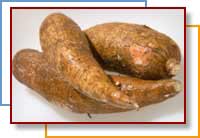
Yucca root has made a home growing in Florida since the late 1800s.
Cassava is a bushy perennial that can grow as tall as 8 feet. The white
interior of yucca is firmer than potatoes and has high starch content. Fresh
yucca has thick, dark brown skin that resembles a tree's bark. Fresh yucca
is available year round. Look for firm blemish free tubers. Store whole
yucca as you would potatoes, in a cool, dark, dry place for up to one week.
Peeled yucca covered with water and refrigerated or wrapped tightly and
frozen for several months.
Yucca can easily be substituted for potatoes in soups and stews and it
contains a high amount of vitamin C and carbohydrates. It is also a good
source of dietary fiber and contains approximately 120 calories per 1 cup
serving.
|
|
Jicama |
Serving size 60g,
1/2 cup raw, sliced
|
Amounts
Per Serving |
% Daily
Value |
|
Calories 25 |
|
| Calories
from Fat 0 |
|
| Total Fat 0g |
0% |
| Sodium
0mg |
0% |
| Cholesterol
0mg |
0% |
| Total
Carbohydrate 5g |
2% |
|
Dietary Fiber 3g |
11% |
|
Sugars1g |
|
| Protein
0g |
|
| Vitamin A |
0% |
| Vitamin C |
20% |
| Calcium |
0% |
| Iron |
2% |
Percent Daily Values are based on a
2,000 calorie diet. |
|
| |
|
Jicama
Jicama is a relative of the potato family. It is a popular dietary
staple in Latin America and widely grown in Mexico and Central America.
There are many names for Jicama including: the Mexican potato, Mexican yam
bean, ahipa, saa got, Chinese turnip, lo bok, and the Chinese potato.
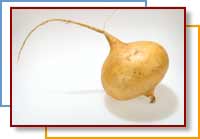
Jicama looks similar to a turnip or a large radish, and it can be used as
an alternative to the water chestnut. Its skin is thin and can be gray, tan,
or brown in color. Additionally, it has a short root and contains white
flesh. The skin is typically peeled before eating it raw. Raw jicama tastes
similar to a pear or apple. It also does not discolor when exposed to the
open air for awhile. Because of this, raw jicama is often used as an
accompaniment to raw vegetable platters. When jicama is used in cooking it
tends to take on the flavors of the ingredients that it is being combined
with. Therefore, jicama is a nice complement to various stir-fry dishes
because it blends well with many vegetables and seasonings.
Jicama is a very versatile vegetable that contains a high amount of
vitamin C, is low in sodium, and has no fat. One adult serving of jicama,
which is equal to approximately 1 cup of cubed jicama or 120 grams, also
contains only 45 calories.
Jicama is available year-round. When purchasing jicama, select tubers that
are firm and have dry roots. Make sure that the jicama has an unblemished
skin and that is not bruised. Once purchased, store jicama for up to two
weeks in a plastic bag in your refrigerator.
|
|
Sunchoke |
Serving
Size 1/2 cup raw, sliced
|
Amounts
Per Serving |
% Daily
Value |
|
Calories 55 |
|
| Calories
from Fat 0 |
|
| Total Fat 0g |
0% |
| Sodium
2.5mg |
0% |
| Cholesterol
0mg |
0% |
|
Total Carbohydrate 13g |
4.5% |
|
Dietary Fiber 1g |
4% |
|
Sugars 2g |
|
| Protein
1.5g |
|
| Vitamin A |
0% |
| Vitamin C |
5% |
| Calcium |
1% |
| Iron |
12.5% |
Percent Daily Values are based on a
2,000 calorie diet. |
|
| |
|
Sunchoke
A relative of the sunflower, this vegetable is native to America, not
Jerusalem, and has no botanical relation to artichokes. In fact, these
tubers are actually a member of the Sunflower family. The white flesh is
nutty, sweet and crunchy like chestnuts when raw. Baked in their skins,
they become more like potatoes with a mild taste of artichoke hearts.

The Jerusalem artichoke is widely grown in gardens in Texas and is
harvested in the fall for highest quality. Widely available in supermarkets,
its peak period is September through January, but often continues through
the early spring.
Select firm sunchokes that are firm and free from mold and wrinkles.
Sunchokes vary in color where their shades range from dark brown to light
brown in color, similar to ginger.
These tubers need be refrigerated, unwashed, in a plastic bag for up to 1
week for successful storage.
|
|
Taro Root |
Serving
size 1/2 cup raw, sliced
|
Amounts
Per Serving |
% Daily
Value |
|
Calories 55 |
|
| Calories
from Fat 0 |
|
| Total Fat 0g |
0% |
| Sodium
5mg |
0% |
| Cholesterol
0mg |
0% |
| Total
Carbohydrate 14g |
4.5% |
|
Dietary Fiber 2g |
7% |
|
Sugars 0.5g |
|
| Protein1g |
|
| Vitamin A |
0% |
| Vitamin C |
4% |
| Calcium |
2% |
| Iron |
1% |
Percent Daily Values are based on a
2,000 calorie diet. |
|
| |
|
Taro Root
The taro root, as with other tubers is recognized by other names. This
tuber is also known as dasheen, eddo and kalo in many areas of the world
including West Africa, Asia, Central America, South America and the
Caribbean and Polynesian islands. This root is most well-known as the
ingredient of the Hawaiian dish "poi," or mashed taro root.
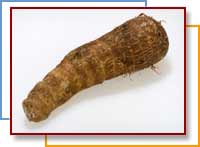
Taro root is a starchy vegetable that is commonly used in place of a
potato. Its hairy outer coating on its surface is similar to a coconut. The
hairy outer layer is always removed with caution since skin irritation can
arise caused by the juices secreted by the taro root. It is recommended to
use protective rubber gloves when handling this tuber. Taro root is toxic in
its raw form so always cook it before eating.
These tubers take on a nut-like flavor when cooked. Frying, baking,
roasting, boiling, or steaming them as an accompaniment to meat dishes are
all common uses. Soups and stews are other dishes that taro root suits well.
Select tubers that are firm, hairy, with no wrinkling. Store the roots
for up to one week in a cool and dry location, making sure that the roots do
not dry out.
|
|
Water Chestnut |
Serving size
1/2 cup raw, slided (62g)
|
Amounts
Per Serving |
% Daily
Value |
|
Calories 60 |
|
| Calories
from Fat 0 |
|
| Total Fat 0g |
0% |
| Sodium
10mg |
0% |
| Cholesterol
0mg |
0% |
| Total
Carbohydrate 15g |
5% |
|
Dietary Fiber 2g |
7% |
|
Sugars 3g |
|
| Protein
1g |
|
| Vitamin A |
0% |
| Vitamin C |
4% |
| Calcium |
0% |
| Iron |
0% |
Percent Daily Values are based on a
2,000 calorie diet. |
|
| |
|
Water Chestnut
The water chestnut, resembles a chestnut in color and shape, is also
known as the Chinese water caltrop. This tuber is commonly associated
with Chinese cooking, but is finding its way into other ethnic meals.
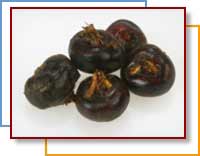
Hailing from Southeast Asia, water chestnuts are actually roots of an
aquatic plant that grows in freshwater ponds, marshes, lakes, and in
slow-moving rivers and streams. These roots are commonly grown in Japan,
Taiwan, China, Thailand, and sometimes in Australia. Water chestnut
harvesting is laborious, making them somewhat expensive to purchase.
Processed and canned water chestnuts widely found in most supermarkets.
However, fresh water chestnuts, are more difficult to find, but are becoming
more available.
If you find fresh water chestnuts, select those that are firm with no
signs of wrinkling. These will need to be peeled prior to eating and
cooking. Stored fresh tubers need to be wrapped tightly in a plastic bag for
up to one week.
Canned, unopened water chestnuts will store indefinitely. Once opened,
canned tubers will keep up to one week in a bowl of water. Be sure to change
the water daily for the ‘freshest’ product.
Recipes
Simple Yucca Simmer
Makes 4 servings
Each serving equals 1/2 cup of fruit or vegetables
Source: Melissa’s World Variety Produce Chef Ida Rodriguez
Ingredients
2 lb Yucca Root (1/2 pound per person)
2Tbsp lemon juice
2 cloves garlic chopped
2 Tbsp chives
½ tsp salt
1/8 tsp ground black pepper
Rinse yucca well, peel and halve lengthwise. Remove fibrous core.
Combine lemon juice, garlic and fresh herbs in a large pot with enough
water to cover yucca. Bring to a boil and add salt. Lower heat and add
cold water when necessary so as not to allow water to reach another boil.
Pierce with toothpick or fork. When soft (not mushy) remove pieces and set
aside. When all pieces are done, drain, sprinkle with pepper and serve
hot.
Nutritional analysis per serving: Calories 373, Protein 4g, Fat 1g,
Calories From Fat 2%, Cholesterol 0mg, Carbohydrates 88g, Fiber 5g, Sodium
269mg.
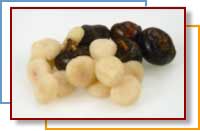
Find more in our
recipe database!
|



